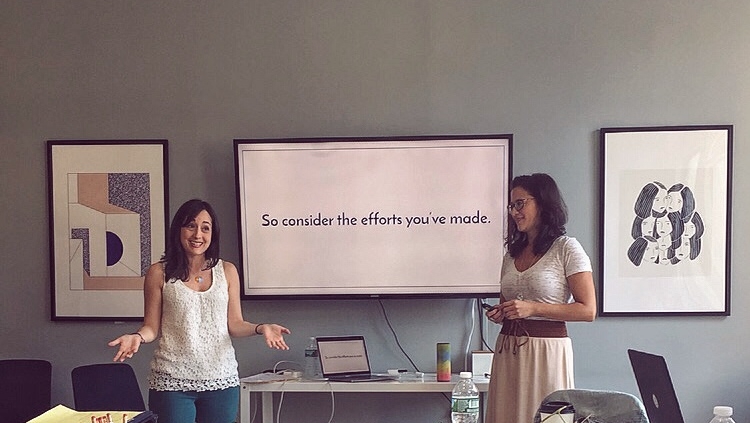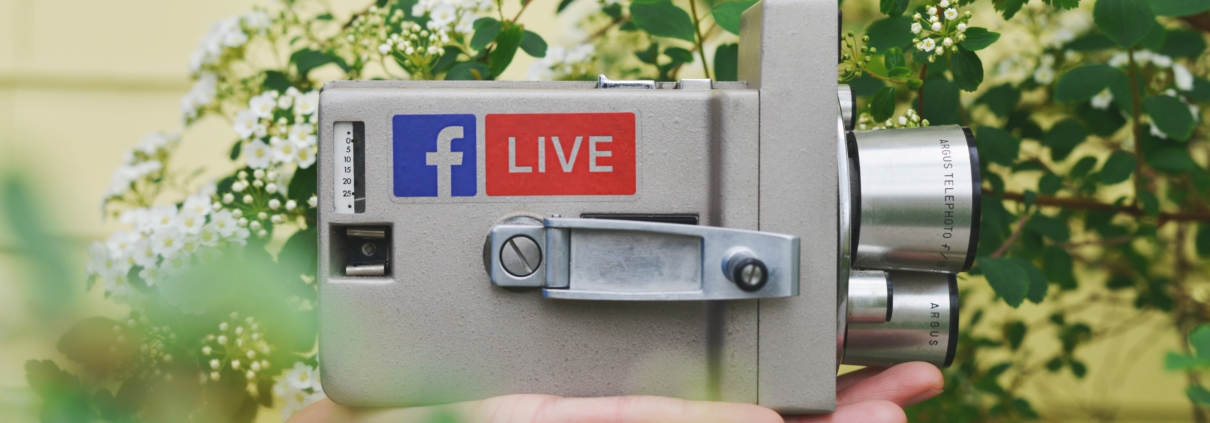On August 18th-20th, we had our very first event called Lights Camera Expert LIVE! We are beyond grateful to have finally laid eyes (sans screen) on some of our amazing students from our course. Participants flew into Manhattan from all over the country for a weekend jam-packed with media training, brand excavation, pitch development, and networking.
We kicked things off Friday night with a delicious dinner at Urban Fare, where participants got to network with producers, editors, and established media experts. Then, Saturday and Sunday were packed to the gills with workshops, seminars, and on-camera interview training.
Though we may have technically been the teachers, we learned a lot from our students over the weekend:
1. Your expertise doesn’t lead—you do.
Saturday afternoon, Terri led a seminar on storytelling—how to set the scene, pull from all five senses, and plop your audience into the moment you’re sharing. It’s easy to get bogged down in the how and what of your mission, but as we dug into each student’s origin story, we reconnected to who they really are and why they do what they do.
As each student shared, each of us became invested in their mission on a much deeper, more personal level. It became clear that when you lead with your story and your passion—and lean into the power of your vulnerability—your audience can’t help but connect with you (and root for your success).
2. You are a secret pitch machine (yes, you!)
Believe us: There is no subject too dry, no niche too narrow. By following Paula’s Anatomy of the Pitch, we saw how thinking outside the box can produce limitless ideas for content. First, each student brainstormed possible topics and angles. Paula walked them through what is most likely to catch a producer’s eye. We zoomed in on one angle and gathered all of the possible talking points and, most importantly, audience takeaways. In the process, not only did every student come away with a ready-to-send pitch, they generated a long list of potential pitches that have already been crowdsourced.
A lot of people think that by getting too specific, they’ll lose something in the process. But this weekend, we were blown away by how many new pitch ideas were generated when students committed to going deep on one idea. Getting specific about one thing doesn’t discard other possibilities—it sheds a brighter light on all of them.
3. Don’t pitch your expertise—sell the transformation.
Often, as experts, we get bogged down in selling the features and facts (because we love our facts)! Our passion for a particular subject leads us to believe that it should be the focal point. But our Avengers Team of expert students this weekend came from a multitude of backgrounds. And when they explained how they help people, as opposed to what they do, eyes around the room lit up. Questions poured out and ears perked up, no matter how unfamiliar the subject matter.
Bottom line: Not everyone cares about sleep studies, but everyone wants to feel well-rested. If you can tell us how to change our lives for the better, any subject is sexy! Your brand can be summed up in one fill-in-the-blank sentence: “I help (these kinds of people) to (benefit #1) and (benefit #2).” That’s it!
4. Your media career should boost your brand (not the other way around)
One of our students said, “Money makes a great servant and a terrible master.” The same goes for media. When we looked out at our group, we saw an encouraging variety of talents, voices, and strengths. Some of them have started their own podcasts and TV shows, while others are already heavy hitters on the radio circuit or getting published in major publications. It was refreshing to see how each student has made their media journey fit their needs, strengths, and vision.
There is no set, traditional media path! If your real strength is hosting the conversation, start a podcast. (We can help you do it! Email us at paula@paularizzo.com if you want to start one but don’t know where to start) If being the world’s best radio guest fits better than the Today Show, do it! You are launching a media career to aid your mission—not the other way around. Do what serves and the results will follow.
If you’re not already hosting a weekly Facebook Live show, it’s time to start putting yourself out there. That handy-dandy LIVE function at the top of your newsfeed is not only a powerful marketing tool for boosting your business and brand, it’s a free, simple, and convenient way to demonstrate your on-air potential to producers.
Not to mention you’ll get much needed practice capturing an audience’s attention—and a clear sense of what makes them keep scrolling.
So here it is. Your step-by-step guide to hosting your own show on Facebook Live!
Step 1: Set Up Your Space
First things first, be sure you have a Facebook Page for your business—and not just a personal page. You can—and should—share your professional page posts via your personal profile. But having a business page will allow you to track the analytics of engagement—vital information for growing your following.
Second, having the right gear can make all the difference in quality. Putting your iPhone on a tripod, setting it in widescreen, and using a wide lens accessory can make your shoot look more professional. We swear by this microphone from Amazon and this stand. If you want to be fancy, here’s a great clip-on lav mic that we use. And the right lighting and scenery can make you look like a total pro. Don’t be afraid to experiment in your home with what makes you look best!
(Pro tip: Do NOT shoot directly into a window or direct lighting (meaning, don’t shoot with a bright light or window behind you) – it will make your shot dark and unusable.)
Step 2: Plan Your Broadcast
The beauty of Facebook Live is that it doesn’t have to high production quality, it just has to deliver high value to your audience. Use our media-readiness test to make sure your content will resonate.
Get creative about what you share. The next wave of social media influencers don’t just share their wisdom, they are all about demonstrating the process—just look at the impact of Snapchat and Instagram stories. Don’t be afraid to give your viewers a behind the scenes look at what you do and how you do it!
Keep in mind that FB Live isn’t only live: Create your content with the repost in mind. People will be watching this way after you hit stop.
Step 3: Go Live!
Here’s a structure to keep you on track throughout your broadcast:
-
- Give a brief, powerful introduction. Give 1–2 sentences about what you’ll be sharing—and why you’re the person who is qualified to share it. “Hi guys, today I’m going to share with you the five reasons your business isn’t getting enough attention. I’m a video producer with 25 years of experience in helping brands boost their visibility.”
- Get into the meat of your content. This is where you deliver on the promise of the premise. Give the people what they want and share your wisdom here!
- Have a Q&A. Encourage viewers to post their questions in the comments. And look, if you’re new to this and no one tunes in the first time, don’t sweat it. Skip the Q&A until you’ve got a following of even a couple of people—or get your network to jump on and ask some good questions!
- Call to action. Ask them to subscribe to your page or mailing list, check out your site, message you with questions or topics they’d like you to address, and follow follow follow.
Finally, and this is a biggie, share it with your network well in advance so they know when it’s happening, can get excited, and are sure to attend!
Step 4: Edit and Share
Once you’re finished, your broadcast gets posted as a video. But here’s a beautiful insider tip: You can (and should) edit that video! See that cute little drop down in the top right hand corner of your post? Click Edit Video and it will let you change the title, thumbnail, add subtitles, etc. Here’s a quick tutorial.
Be sure to pick a fun and flattering thumbnail. Edit your post for posterity—change any “LIVE NOW” text to simply reflect the title.
And, most important of all, be sure to follow this tutorial to add captions to your video. The truth is, 80% of videos on Facebook are viewed with no sound at all! (Raise your hand if you watched videos at work with captions only. Yea, we thought so). That visual component can make all the difference in quality and capturing views moving forward—don’t skip it!
And now that you’re up and rolling, keep your viewers coming back for more.
Plan out weekly broadcasts and keep evolving your content based on the response. In no time, you’ll have a devoted following—and plenty of media worthy clips to share with producers.
If you’re interested in a new FB Live training we’re putting together click here and add your name to our early notification list. You’ll be the first to know when the step-by-step training class is happening!
You did it! You took the plunge, crafted a pitch you’re proud of, and you’re chomping at the bit to finally hit send on that Bad Mama Jama. And let’s be clear—we’re super proud of you! You’re facing your fears, owning your expertise, and finally stepping into the spotlight where you belong.
But before you hit send, let’s double check your work one more time. Because both of us know firsthand that there are a few key things that help greenlight a great pitch—and without these pieces, your great idea could end up in the bad pitch folder. Consider this your pre-send checklist for pitch perfect media outreach.
Check One: Is your pitch specific?
Make sure your pitch is as specific as possible. Tell them what problem you’re solving, how you’re solving it and—the most important part—why their audience should care! And if you can do all of that while passing the ultimate media-readiness test, you’ve nailed a great pitch.
BONUS: Give them a counterintuitive angle with an interesting hook. What does everyone get wrong or have backwards about your industry? What small detail changes your clients’ lives in a big way?
Producers would much rather book the nutritionist who says, “Our culture has bought into the lie that fat is the enemy. I’d love to do a segment on why bacon is healthy—and how a fat rich diet actually melts body fat.” Now THAT has our attention!
Check Two: Does it match their brand?
Pitching isn’t as easy as creating a template and blasting a thousand emails into the media ether. What works for Buzzfeed will not work for MindBodyGreen will not work for The New Yorker. It’s kind of like television: You could probably pick up a script for a comedy TV pilot and figure out pretty quickly whether it belongs on CBS or HBO.
You significantly increase your chances of rising to the top of the flood of pitches producers and editors receive if you make it clear that you understand the media outlet’s brand. What kinds of stories have they run in the past? How do they incorporate humor? Are they family-friendly or edgy? Is there a throughline or theme to the kind of content they gravitate toward?
Check Three: Will it resonate with their audience?
The best pitches visualize one very specific person and tailor the advice to helping that person solve a problem. To take your pitch to the next level, you need to identify who that ideal audience member is for each outlet you pitch. And it helps to get as specific as possible.
Let’s pretend that the walking embodiment of a Today Show viewer is a 38-year-old mother of two living in Mesquite, Texas. And let’s pretend that the walking embodiment of a HelloGiggles reader is a 24-year-old administrative assistant living in Brooklyn.
If you were a relationship therapist, you would approach those two clients entirely differently—and the same goes for your pitch. You might pitch a piece on surviving the “Seven Year Itch” to the Today Show, but a piece on tweaking your Tinder profile might go over better at HelloGiggles. By researching the outlet’s audience, you also save yourself—and producers and editors—precious time by not wasting good material on people who don’t need it.



